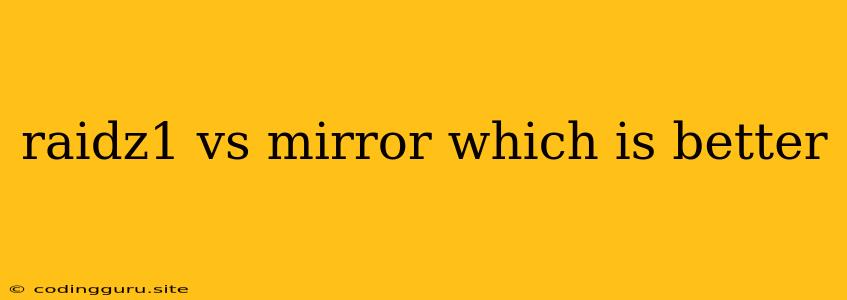RAIDZ1 vs Mirror: Which Is Better for Your Needs?
When it comes to protecting your valuable data, RAID (Redundant Array of Independent Disks) offers a reliable solution. But with various RAID levels available, choosing the right one for your specific needs can be challenging. Two popular options often come into the picture: RAIDZ1 and Mirror, each with its own strengths and weaknesses. This article will delve into these two RAID levels, comparing their characteristics and helping you determine which is the better choice for your setup.
What is RAIDZ1?
RAIDZ1 is a RAID level that utilizes a technique called "parity" to protect your data. It requires at least three disks, with one disk acting as a parity disk. This parity disk stores information about the other data disks, allowing the system to reconstruct data in case one disk fails.
Here's how it works:
Imagine you have three disks (A, B, and C). Disk C is your parity disk. If Disk A fails, the system can use the parity information stored on Disk C to rebuild Disk A's data.
What is Mirroring?
Mirroring, also known as RAID1, is a simpler RAID level that involves creating an exact copy of your data on a second disk. This means that both disks contain identical data.
Here's how it works:
Let's say you have two disks (A and B). If Disk A contains your data, Disk B will be a perfect mirror of Disk A. If Disk A fails, Disk B can take over without any data loss.
RAIDZ1 vs Mirror: A Comparison
Now that we understand the basics of both RAIDZ1 and Mirror, let's dive into a head-to-head comparison to see their key differences:
| Feature | RAIDZ1 | Mirror |
|---|---|---|
| Data Protection | Data can be reconstructed from parity information | Data is duplicated, providing an exact copy |
| Number of Disks Required | At least 3 | At least 2 |
| Capacity | Less capacity than Mirror due to the parity disk | Maximum capacity of the smallest disk |
| Performance | Slightly slower than Mirror due to parity calculations | Faster than RAIDZ1 |
| Cost | More affordable than Mirror | More expensive due to the need for identical disks |
| Reconstruction Time | Longer than Mirror | Faster than RAIDZ1 |
| Complexity | More complex to implement | Easier to set up and manage |
RAIDZ1 vs Mirror: When to Choose Each Option
RAIDZ1 is generally a better choice when:
- You need to maximize storage capacity. RAIDZ1 allows you to store more data than Mirror, as you don't need to dedicate an entire disk to mirroring.
- You are on a budget. RAIDZ1 is typically more cost-effective compared to Mirror, as you can use less expensive disks for parity.
- You are willing to accept slightly slower performance. While RAIDZ1 offers good performance, it may not be as fast as Mirror.
Mirror is a better choice when:
- Data integrity is paramount. Mirror offers the highest level of data protection as it provides an exact copy of your data.
- You prioritize speed. Mirror offers faster performance than RAIDZ1 due to the lack of parity calculations.
- You are willing to pay more for redundancy. Mirror requires identical disks, which can be more expensive.
Choosing the Right RAID for You
Ultimately, the best RAID level for you depends on your specific needs and priorities. Here are some questions to consider:
- What kind of data are you storing? Are you storing critical business data or personal files?
- What is your budget? How much are you willing to spend on storage hardware?
- What are your performance requirements? Do you need fast read/write speeds?
- What is your tolerance for downtime? Can you afford to wait for data reconstruction if a disk fails?
By carefully considering these factors, you can make an informed decision about which RAID level is right for you.
Conclusion
Both RAIDZ1 and Mirror are powerful RAID levels that offer excellent data protection. RAIDZ1 provides a good balance between capacity, cost, and performance, while Mirror excels in data integrity and speed. The best choice for you will depend on your specific needs and priorities. By understanding the pros and cons of each option, you can make an informed decision that ensures your data is safe and accessible.
